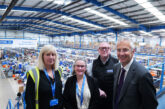
Today, homes represent 20% of global CO2 emissions worldwide which is a sobering reminder that there is still a long road ahead to achieve our climate targets. To get to our Net-Zero goal, we must bring homebuilders, mortgage providers, homeowners and residents onside and empower them with the right technologies and solutions to help fight against climate change.
As more and more smart home devices are powered by clean electricity – from heating to cooking to personal transportation – we have an opportunity to decarbonise our dwellings at pace without changing our digital and connected lifestyles. This is now possible through cutting-edge technology and innovation, with positive, sustained change truly starting at home.
The focus on climate change and sustainability is now becoming omnipresent for homeowners, home builders and policy makers. This is reflected in the UK government’s move to mandate the installation of residential electrical vehicle charging points from 2022. With the technology available, it’s time for home builders and homeowners to invest in it and make Net-Zero a reality.
Barriers homes must overcome
The increase in electric vehicles could double residential energy usage, potentially becoming one of the biggest changes since electricity was first widely used. Add to that electric heating and cooking and the residential market will be severely disrupted. The time to act is now. By 2050, households are expected to be the single largest consumer of electricity and the biggest contributor of CO2 emissions, with 34% generated by homes. We know consumers want to make changes and we need to empower them to do so by putting them in the driver’s seat when it comes to sustainable living.
Our Powering Change report discovered that 50% of Brits think it is important to make their home carbon neutral within their lifetime, and 66% consider sustainability to be important when making home improvements. The majority (84%) are also concerned about rapidly rising energy bills should global temperatures increase by more than 1.5 degrees.
There are 30.1 million homes across the UK and Ireland today, and we’re going to have to retrofit 26.5 million of them to meet targets. Our current progress is too slow. Currently, around 12% of homes globally are smart – but smart doesn’t mean sustainable. While the number of smart devices in our homes has dramatically increased, the well-being of the planet has not. Brits are 50% more likely to own a voice assistant than a smart thermostat, with just 51% viewing smart controls in the home as important – and yet digital is essential to achieving a Net-Zero home.
The power of smarter and more sustainable homes
Governments are striving to ensure the reliability of energy supplies and a cleaner energy mix. Homebuilders are looking for ways to make smart and sustainable homes a key differentiator, while businesses strive to equip consumers with easy to use and intuitive solutions to spearhead climate change action from their living rooms.
Investment in smart, sustainable homes yields benefits to both the builder and the owner or tenant. We typically see a 30% reduction in energy usage and a similar reduction in operational costs as a direct result of smart building technologies. Better performing buildings can attract an increased sale value of up to +14% in the residential sector. The corresponding increases in rental values are +1.4% to +5.2% for residential properties.
Not only are smarter and more sustainable homes essential for reaching our Net-Zero targets, they also offer a financial benefit. When around 40% of people expect sustainability technology to be embedded in the housing infrastructure for new builds, now is the time to ensure that is the case.
Bringing Net-Zero closer with at-home energy management
We know we all must do more to understand and manage our energy use through technology – from plugs and sockets to electric ovens and EVs – but it can be difficult to know where to start.
Smart heating systems offer the ideal foundation for a more sustainable future. They allow users to switch heating on or off from a smartphone app, heat only specific rooms, and utilise self-learning features to avoid wasting energy.
Multizone smart heating helps to drive energy bills down, makes homes more comfortable for residents, and increases a home’s sustainability. It’s a quick and simple way to begin adapting for a more planet friendly lifestyle.
To achieve our Net-Zero targets, there needs to be more emphasis on retrofitting existing building stock, with incentives – helping to save energy, alleviate fuel poverty, and make households more sustainable. We also need to create minimally acceptable standards for all buildings, old and new. Finally, we need to find new ways of delivering sustainability by leveraging existing technology, both digital and electric.
For more information on Schneider Electric click here








